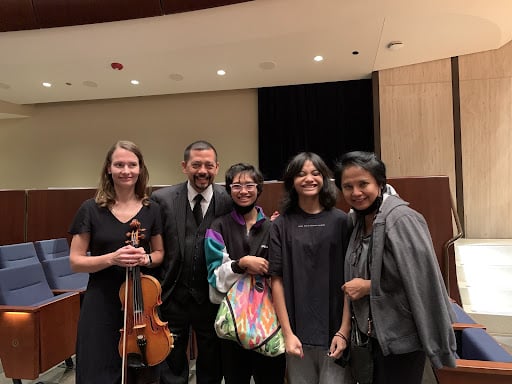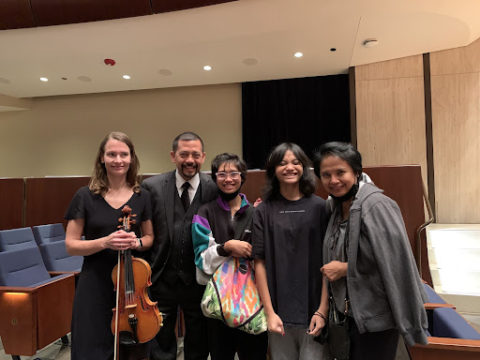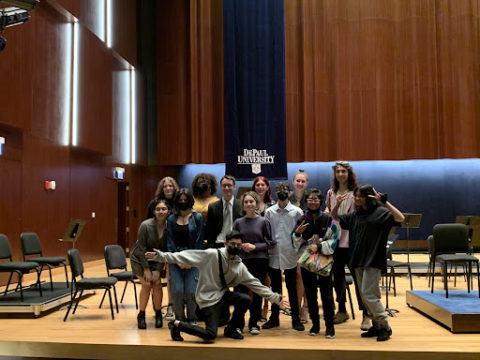Violin Fellow Mahalia Hernandez attended and reviewed a concert that just happened to include another CMPI Fellow, cellist Jan Vargas Nedvetsky, as a soloist. Here are her reflections.
The Oistrakh Symphony Fall Concert was held on September 18, 2022 at the Gannon Concert Hall of the Holtschneider Performance Center at the DePaul University School of Music. The concert was performed by the Oistrakh Symphony of Chicago, conducted by Mina Zikri, and featured cellist Jan Vargas Nedvetsky, who is both a CMPI Fellow and a Fellow at the Academy of the Music Institute of Chicago.
Jan performed the Cello Concerto No. 2 in D Major by Franz Joseph Haydn, a Classical period concerto for cello. Haydn’s concerto was written for cellist Anton Kraft and it first premiered on March 24, 1784 at Hanover Square, London. Haydn wrote the concerto during his time as Kapellmeister at the Esterháza Palace, where he assisted with chamber music, commissioned compositions, and presented operas and concerts on a weekly basis. The concerto’s first premiere was presented by flutist and composer, Willoughby Bertie, 4th Earl of Abingdon, and the soloist was renowned cellist, James Cervetto, who was the principal cellist of the Italian Opera in London.
- Group photo with my former private lesson teacher of 10 years, Zhanna Bullock
- Group photo with the conductor, Mina Zikri (on the right)
- Group photo with the Lincoln Park High School orchestra teacher, Martin Nocedal, Lincoln Park High School orchestra student teacher Georges Mefleh, and the Lincoln Park High School students that attended the concert
The first violins contributed to this concerto by playing the melody before Nedvetsky made his entrance. The violins served as an echo for Nedvetsky and would also briefly play in harmony with him, but they yielded back from overpowering him by playing fewer dynamics and notes that had contrasting values to the ones played by him. Once the orchestra broke out into a tutti, the first violins retrieved their role in playing the melody as they did in the beginning of the first movement.
Nedvetsky was required to use different types of techniques throughout the concerto, such as how he would play legato bowing for long slurred notes and switch up seconds later to staccato bowing for quicker and separate notes. Nedvetsky played grouped notes that sometimes had trills, and he also played scales and arpeggios that rarely ended with harmonics. Nedvetsky played on the upper part of the fingerboard, which could be due to Haydn’s goal of treating the cello as a solo melodic instrument over a bass line accompaniment. It wasn’t until the second movement that Nedvetsky queued the orchestra into playing, and he did so by glancing at the conductor and exchanging a nod with him. A more memorable moment was when Nedvetsky made a vicious entrance into the key change of the third movement which completely shut out the graceful and elegant transition that was played by the orchestra.
I was pleasantly surprised by the concerto because I saw how each instrumental section had its own role, while also working with every other section to maintain the soloist’s spotlight. In a more narrow sense, I absolutely enjoyed the third movement because of the different musical traits it holds, such as the number of techniques that were incorporated by Nedvetsky and how much the mood changed from dynamics and the key change. In conclusion, I would have to say that the concerto has deepened my love for the cello and has created a different outlook on the instrument for me.
The concert also included Symphony No. 30 in D Major, K. 202 by Wolfgang Amadeus Mozart, a Classical period symphony for orchestra. Mozart’s symphony was written in Salzburg, Austria, and completed on May 5, 1774. It was written as a score for two oboes, a bassoon, two horns, two trumpets, strings, and the timpani. However, the timpani part has been lost with attempts over time to recreate it; for the time being, it’s remained lost.
The violins used their bows lightly by tilting them and not adding as much pressure to them. The violins’ bowing gave an illusion that they were moving elegantly, which contributed to the pleasantness of the piece. I noticed that the second violins played on the upper half of their bows and they contributed as an echo for the first violins. However, the second violin at some point would also overpower the first violins by either playing louder or taking the role of playing the melody. Despite the dichotomy that the violins live by in some parts of this piece, there were some parts where they played in unison, and for the majority of this symphony, both violin sections played quick notes. I personally think that the togetherness played in certain parts of this symphony demonstrates one of the elements that make music from the Classical period unique from other musical periods.
The horn contributed to this symphony by sustaining notes which balanced the key and tempo (especially when the orchestra broke out into fast-paced rhythm). The horn would also play in unison with the orchestra, such as at the end of phrases and in moments when the strings had to play softly. And to exaggerate the extravagance that makes music from the Classical period unique, the horn came out the most in the finale of the fourth movement.
I enjoyed this performance, considering that I have a fondness for music by Mozart. I enjoyed the energy yet pleasantness of the symphony. The contrast of notes, rhythm, and tempo produced by different instruments was very ear-complementing. I especially enjoyed the brass and woodwinds in this symphony, as they perfectly demonstrated the eloquence of music from the Classical period, and the most exciting part of my attendance was witnessing my orchestra teacher from my school, Mr. Nocedal, and my former private lesson teacher of 10 years, Mrs. Bullock, playing together, which came to show how small the classical music world truly is.
Images
Provided by Mahalia Hernandez



